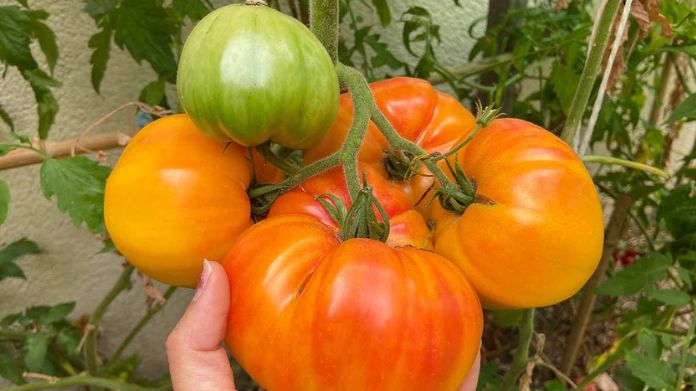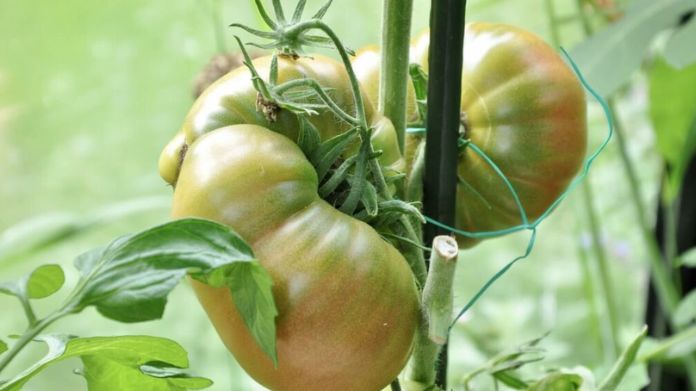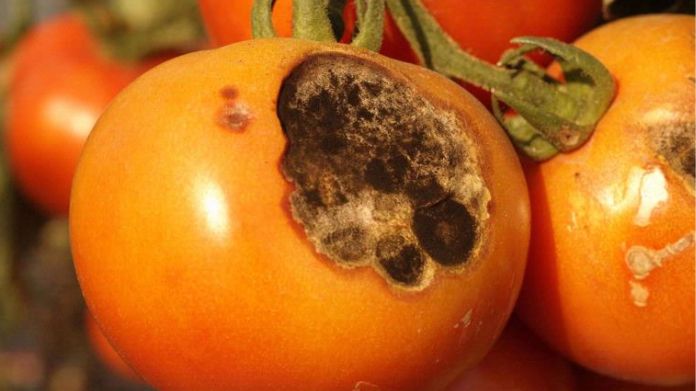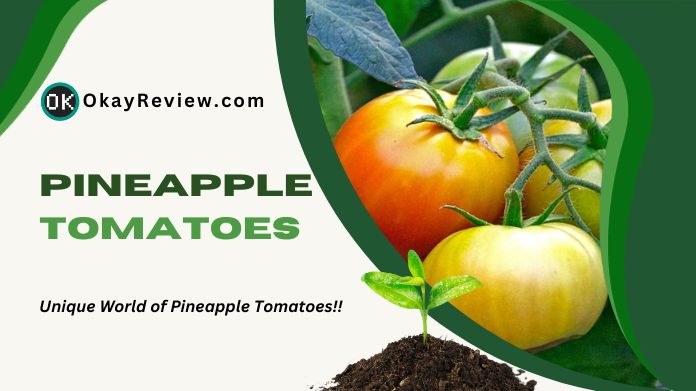Ah, the Pineapple Tomato! No, it’s not a tropical fruit posing as a tomato, nor is it the result of a wild night out between a tomato and a pineapple.
A unique variety of tomatoes has been turning heads and tickling taste buds in gardens everywhere.
If you’ve ever thought, “I wish my salad had a bit more pizzazz,” or “My sandwich could use a tomato with a twist,” the Pineapple Tomato might be your garden’s next superstar.
Discover what makes them unique and how to cultivate them in your garden.
Table of Contents
What Are Pineapple Tomatoes?
 Pineapple Tomatoes might sound like a tropical fruit experiment, but they’re all tomatoes – and what a tomato they are!
Pineapple Tomatoes might sound like a tropical fruit experiment, but they’re all tomatoes – and what a tomato they are!
These heirloom beauties dazzle with their vibrant red and yellow swirls, making every slice a visual treat.
But don’t be fooled by their artsy appearance; they pack a flavor punch too. Imagine a tomato that’s sweet yet tangy, with a fruity zing that might remind you of, well, a pineapple.
Perfect in salads, divine in sandwiches, or just nibbled straight from the garden, Pineapple Tomatoes are the showstoppers of the tomato world, proving that tomatoes can be both eye candy and a taste sensation.
How to Grow Pineapple Tomatoes?
 Growing Pineapple Tomatoes is a delightful journey that rewards gardeners with vibrant and flavorful fruits.
Growing Pineapple Tomatoes is a delightful journey that rewards gardeners with vibrant and flavorful fruits.
While unique in taste and appearance, these heirloom tomatoes follow a process similar to other tomato varieties.
Here’s a step-by-step guide on how to nurture these beauties in your garden:
1. Choosing the Right Location
For Pineapple Tomatoes to thrive, they need a sunny spot. Ensure they receive at least 6-8 hours of direct sunlight daily. A well-draining soil is also crucial to prevent root rot and other complications.
2. Planting Pineapple Tomato Seeds
Start by planting the seeds indoors 6-8 weeks before the last expected frost. Once the seedlings have at least two sets of true leaves and the threat of frost has passed, they can be transplanted outdoors.
3. Watering and Fertilizing
Pineapple Tomatoes prefer deep, infrequent watering. Make sure the soil is regularly damp but not wet. A balanced fertilizer can be applied every 2-4 weeks to support their growth.
And while doing that, remember the aesthetics of your garden; always store the hose properly after its use.
4. Pruning and Supporting
As the plants grow, it’s essential to provide support using stakes or cages. Regular pruning will help increase airflow, reduce disease risk, and boost yield.
Pests and Diseases Affecting Pineapple Tomatoes
 Like all plants, Pineapple Tomatoes are not immune to the challenges posed by pests and diseases.
Like all plants, Pineapple Tomatoes are not immune to the challenges posed by pests and diseases.
Here are some common adversaries of Pineapple Tomatoes and how to combat them:
1. Aphids
These tiny, sap-sucking insects can quickly colonize the undersides of tomato leaves. They not only weaken the plant but can also transmit harmful viruses.
Regularly inspecting plants and spraying with a mild soap solution can help manage aphid populations.
2. Tomato Hornworms
These green caterpillars are notorious for munching on tomato leaves and fruits. Hand-picking them off plants is an effective control method. Introducing beneficial insects like ladybugs can also help keep their numbers in check.
3. Whiteflies
These small, white insects can cause the yellowing of leaves and stunt growth. Using yellow sticky traps and neem oil sprays can help reduce their populations.
4. Blight
This fungus can generate black patches on leaves, leading to wilting and fruit damage. To prevent blight, ensure good air circulation, avoid overhead watering, and remove affected plant parts promptly. Also, most weed killers are available, which can solve this problem.
5. Fusarium and Verticillium Wilt
These soil-borne diseases can cause yellowing of leaves, wilting, and plant death. Rotating crops and planting disease-resistant varieties can help manage these wilts.
6. Blossom End Rot
This condition causes a dark, sunken spot on the tomato’s bottom. It’s due to calcium deficiency and irregular watering. Ensure consistent moisture levels and consider adding lime to the soil if needed.
7. Leaf Spot
Caused by fungi, this disease leads to small, dark spots on leaves. Prevent it by practicing crop rotation, removing affected leaves, and avoiding water splash.
Harvesting and Storing Pineapple Tomatoes
Harvesting Pineapple Tomatoes is a rewarding culmination of gardening efforts, thanks to their vibrant hues and distinct taste.
Understanding the correct harvesting and storage techniques is crucial to maximizing their quality.
Let’s explore how to reap best and store these garden treasures.
1. Harvesting Pineapple Tomatoes
Harvesting Pineapple Tomatoes requires a keen eye and a gentle touch. Typically ready 85 to 90 days after planting, these tomatoes display a vibrant mix of yellow and red when ripe.
Handling them carefully is essential, either twisting them off or using shears for detachment. Regular checks ensure you pick them at their prime because of their rapid ripening, especially in warm climates.
2. Storing Pineapple Tomatoes
The joy of gardening culminates in the moment you get to harvest the fruits of your labor. With Pineapple Tomatoes, this moment is especially delightful,
given their vibrant colors and unique flavor profile. But to ensure you get the best out of your Pineapple Tomatoes, knowing the proper harvesting techniques and storage methods is essential. Let’s delve into the art of reaping and preserving these garden gems.
Benefits of Growing Pineapple Tomatoes
Growing Pineapple Tomatoes in your garden is not just about cultivating a unique variety of fruit; it’s about embracing a multitude of benefits that come with it.
Here below are various advantages of nurturing Pineapple Tomatoes:
1. Exceptional Flavor Profile
Pineapple Tomatoes are renowned for their sweet, fruity taste with hints of citrus. Their rich and complex flavor makes them a favorite among tomato enthusiasts, perfect for salads, sandwiches, or simply enjoying fresh off the vine.
2. Nutritional Powerhouse
Like other tomatoes, Pineapple Tomatoes contain essential vitamins, minerals, and antioxidants. They are particularly rich in Vitamin C, potassium, and lycopene, promoting heart health and boosting the immune system.
3. Hearty Growers
Pineapple Tomatoes are relatively robust and capable of thriving in various climates. They can yield a bountiful harvest properly, ensuring a steady supply throughout the season.
4. Economic Benefits
Growing your Pineapple Tomatoes can be cost-effective in the long run. Instead of purchasing specialty tomatoes at premium prices, you can enjoy a fresh, organic supply from your backyard.
5. Educational Opportunity
Cultivating Pineapple Tomatoes can be an educational experience for children. It offers them hands-on learning about plant growth, responsibility, and the joy of harvesting their produce.
6. Eco-Friendly
Growing your tomatoes reduces the need for store-bought varieties, often with excessive packaging. Plus, homegrown tomatoes mean fewer carbon emissions associated with transporting produce.
7. Therapeutic Benefits
Gardening, in general, has therapeutic qualities, from reducing stress to improving mental well-being. Tending to Pineapple Tomatoes, watching them flourish, and enjoying their fruits can be a rewarding and meditative experience.
Conclusion
Pineapple Tomatoes are a delightful addition to any garden. You can enjoy a bountiful harvest of these juicy, flavorful fruits with the proper care.
Happy Gardening!

